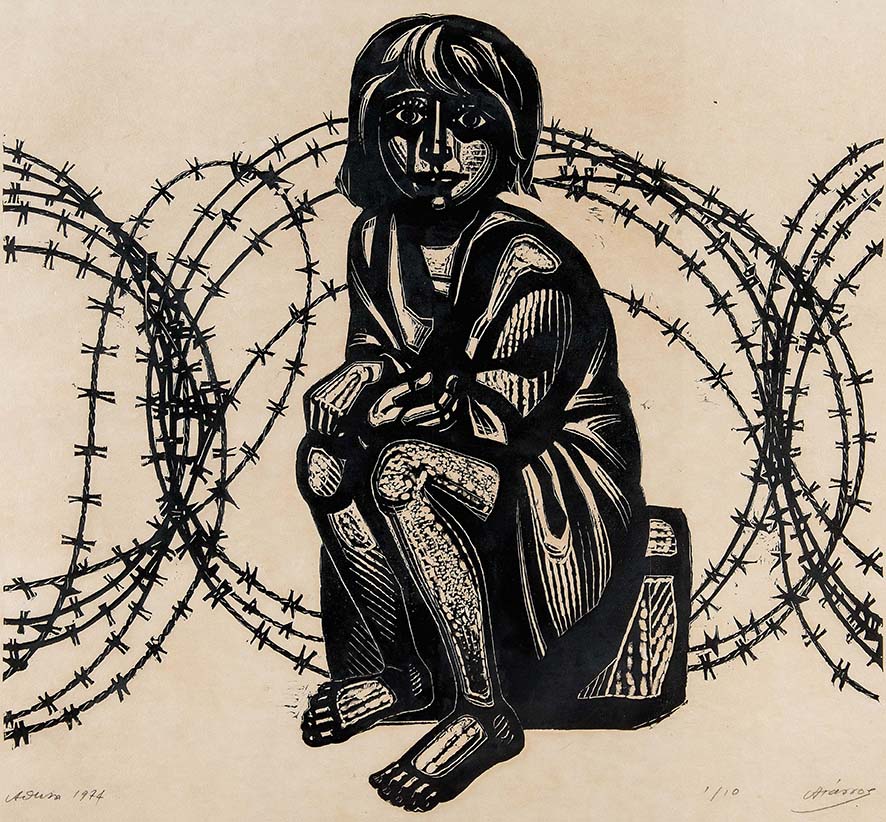“Prosfigosimo: A stamp for the refugees of Cyprus, the story of a symbol”
Address by the Permanent Secretary of the Ministry of Foreign Affairs Ambassador Kornelios Korneliou at the opening of the exhibition entitled
“Prosfigosimo: A stamp for the refugees of Cyprus, the story of a symbol”
”The House of the Citizen”
- Kornelios Korneliou
Ladies and gentlemen,

It is widely accepted that during the long history of humanity, art has expressed in the most deep and profound way the feelings and the human spirit.
In our homeland, art has registered with the darkest colors the tragic moments of our recent history.
During the periods of turmoil, of the 60’s and 70’s, art has depicted the traumatic experiences of all Cypriots, regardless community, and religious background.
Through these tragic moments, the Turkish invasion, and the displacement of hundreds of thousands of Cypriots, arouse the need for the creation of a special stamp for the economic support of the refugee fund. The evolving process for the creation of this stamp passed through various phases.
The first edition which depicted Saint George killing the dragon, an image deriving directly from the island’s religious tradition, was followed by a stamp representing a woman holding a child, struggling to protect it
from a world which was rapidly falling apart.
These tragic events had a great impact on the Greek artist Tassos Alevizos, who created the third version of the refugee stamp, which depicts a Cypriot refugee child enclaved in a barbed wire. The image of a child, victimized by the war consequences, during its most vulnerable phase, will become in the coming years the most iconic
image of the Cyprus tragedy.
The incoming fees became a major income for the refugee fund, which aimed to provide aid and relief to the needs of thousands of displaced people.
At the same time, this iconic image acted as a means of information for the rest of the world about the tragic consequences of the Cyprus tragedy.
Maria Paphitis, through this art exhibition unfolds the line which connects the human grief with history and the arts, the personal stories with the collective memory of our people.
She narrates with great sensitivity the story behind the famous stamp, for which little is known, notwithstanding the major role it has played in our recent history.
In the exhibition we inaugurate tonight, the art historian, Maria Paphitis, encompasses the various forms of this stamp, as well as emblematic art pieces within the same thematic, by renowned Cypriot artists, an act which demonstrates the close connection between the Cypriot refugees with those in Syria, Africa, Asia and beyond
who must go through similar traumatic experiences.
People who are forced to leave behind their homes as well as sites of their religious and cultural heritage, with a hope for a better life.
The exhibition is enriched with photos by Giorgos Pantazis from occupied Varosha, a town enclaved by the war wires like the refugee child at the stamp of Alevizos Tassos, patiently waiting for better days promised by International Organizations and Resolutions.
Ladies and Gentlemen,
This artistic journey brings us face to face with our responsibilities towards all refugees, Cypriots, and others. It acts as a call for the creation of lasting peace in our island and the rest of the world, for establishing bridges of communication between our people, which will prevent in the future wars and the displacement of even more
people.
Finally, I would like to congratulate Maris Paphiti and all those who have worked for the creation of this exhibition and thank the President of the Parliament for hosting these iconic art pieces in this wonderful building, proving the close link between politics and arts, diplomacy and human sensitivity.
Thank you for your attention.
- Monday, 27 March 2023, 6.00 pm
THE THIRD REFUGEE STAMP
 6 May 1976
6 May 1976
The Council of Ministers approved the selection of the engraving by A. Tassos Cyprus 1974 to illustrate the third refugee stamp.
In order to avoid the reprinting of the refugee stamp currently in circulation worth
10 mils and for the purpose of further promoting the refugee problem and greater demand for stamps by the philatelists, it is proposed to print a new stamp depicting the woodcut of the engraver Mr. Tassos “Cyprus ’74″[..].
The validation letter of the order of 10,000,000 pieces by the Aspioti-Elka Graphic Arts Company, in addition to its printing specifications, noted that:
The model will not be charged, but only the cost of its technical processing; the model is offered to Cyprus by Mr. Tassos.
On 29 December 1976, the Office of Public Information issued a short announcement informing the public of the release date of the New Refugee Stamp and also of its represented image.
This depicts the woodcut of the engraver A. Tassos “Cyprus ’74.
The stamp with the woodcut by A. Tassos has been in continuous circulation since
10 January 1977.
During the last forty-six years, it has been issued in several variations related to the color of the background. Furthermore, its sale value was unavoidably adjusted to the currency change (1984, 2004) and it was also periodically subjected to small increases in its price.
The wood engraving pf A. Tassos has left a deep mark both on the general public, as well as, on the artistic production of our country. The latter trend is manifested in multiple artworks created in the decades following the refugee stamp.
- Χαιρετισμός της Προέδρου της Βουλής των Αντιπροσώπων κ. Αννίτας Δημητρίου στα εγκαίνια της έκθεσης
- Χαιρετισμός της προέδρου της Εταιρείας Εικαστικών Τεχνών Α. Τάσσος κ. Ειρήνης Οράτη στην τελετή εγκαινίων της έκθεσης
- Χαιρετισμός της Ιστορικού Τέχνης και επιμελήτριας της έκθεσης κ. Μαρίας Παφίτη στην τελετή εγκαινίων της έκθεσης
- Χαιρετισμός του Γενικού Διευθυντή του Υπουργείου Εξωτερικών κ. Κορνήλιου Κορνηλίου στα εγκαίνια της έκθεσης
